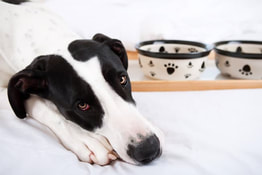 Dog Food for Thought 1/14 Feeding your dog is a ritual that usually brings together a loving owner and a grateful, hungry pet. But when Fido doesn’t eat with much gusto, it can raise a red flag. It’s a good idea to know when it might be a sign of trouble and what you can do if it is. It’s Not a Big Deal to Skip a Meal 2/14 It isn’t necessarily a problem if your dog doesn’t eat every time you put food down. What’s most important is their weight. If that’s steady and their ribs or spine aren’t showing, your friend is probably getting the food they need. They Are Not That Into It 3/14 Not every dog is food-driven, especially the smaller breeds. For some, it just isn’t all that important. They don’t see food as the ultimate reward. They may want your attention or praise, and food is secondary. Pay attention to what motivates your dog. If it’s not treats or mealtime, don’t force it. It Brings Up Bad Memories 4/14 If you have a meal that leaves you with an upset stomach or worse, you probably tend to stay away from what you ate for a while. Your dog might do the same if they link a problem with a certain food. A new type of sustenance may make a difference. Anxiety Can Cause Problems 5/14 Being nervous can zap your dog’s appetite. Just like people, dogs don’t eat as much if they’re anxious. This can happen thanks to things like loneliness, boredom, storms, fireworks, or separation anxiety (being home alone during the work day, for example). If you think anxiety may be why your dog isn't eating, it can help to spend more time with them. 6/14 (This was blank in the original article) Age or Health Can Be an Issue 7/14 If your dog’s lack of appetite is sudden or goes on for a while, especially if your friend is older, ask your vet if you can bring them in for an exam. It can be a good idea to keep an eye on that from month to month. If there are any changes, make an appointment. You Need a New Recipe for Success 8/14 It may be as simple as your dog doesn't like the taste of their food. Still, if you're thinking about changing it up, be cautious. The new food could cause gut problems for your friend, which may keep them off food even longer. If you feel like you must change, do it slowly, mixing a little in at a time in their current food. Better yet, talk with your vet about it. Treats Are More Than Treats 9/14 It’s fine to reward your dog for good behavior, but too many treats can spoil their appetite at mealtime. And if you keep offering them to try to get them to eat, that can send the wrong message. You’re telling your dog they can hold out for something better. Dinner's Boring 10/14 While treats in place of regular food isn’t a good idea, treats with dinner might be. Some dogs who don’t want to eat their meals are really interested in treats. If that’s the case with yours, mix some treats into their food or add canned food, or even just warm water. Some companies make a sauce you can add. You Share Too Much 11/14 Sharing food with your dog may seem generous, but it can do more harm than good. The scraps can add up and make them full by mealtime. It’s hard to know how much you’re giving them under the table. You might think it’s a tiny bite when it’s actually a lot of food for a small dog. Your Friend Likes a Schedule 12/14 Like people, dogs can be creatures of habit. Offer a meal at the same time each day, and give your pet a certain amount of time to eat it, say 15 or 20 minutes. If they don’t eat within that time, take the food away and try it at the next meal. The idea is to set a routine where they know that if they skip this meal, they can eat in a few hours. You May Need to Set the Table 13/14 Getting your pet to eat might be as simple as giving them the comfort of their own dedicated place to eat. Choose an out-of-the-way spot, like a bathroom, where they can eat undisturbed. A safe place where they can take their time to eat might just do the trick. You May Need a Vet's Help 14/14 If your dog’s at a healthy weight but nothing seems to boost their appetite, a veterinarian can offer some guidance. They'll run some diagnostic tests. If those don't uncover anything, they may suggest some trial and error to see what’s going on.
0 Comments
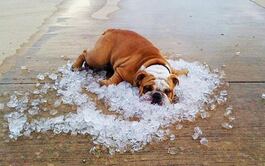 Instead of sweating, dogs eliminate heat by panting. They do have some sweat glands in the footpads, which help with heat dissipation, but only minimally. When panting isn’t enough, a dog’s body temperature rises. This can be fatal if not corrected quickly. Physical Symptoms of Heatstroke in Dogs Excessive panting and signs of discomfort indicate overheating in dogs. A dog overheating may also be unable or unwilling to move around. Other signs of heatstroke in dogs include drooling, reddened gums, vomiting, diarrhea, mental dullness or loss of consciousness, uncoordinated movement, and collapse. Primary Cause of Heatstroke in Dogs Any hot environment can cause heatstroke in dogs, but the most common cause is a careless action by a pet owner, such as leaving a dog in a car or forgetting to provide water and shade to pets that are outdoors. Some dogs are more prone to developing heat exhaustion, especially dogs who are older, overweight or brachycephalic (Pugs, Bulldogs and other flat-faced breeds). It is important to be aware of the ambient temperature and take appropriate preventative measures. Dogs with thick fur, short noses or those suffering from medical conditions such as laryngeal paralysis and obesity are predisposed to heatstroke. Even dogs who enjoy constant exercise and playtime—like working dogs such as Labrador Retrievers and German Shepherds—should be closely monitored for symptoms of heatstroke in dogs, especially on hot days. Immediate CareIt is essential to remove the dog from the hot environment immediately. Do not give the dog aspirin to lower its temperature; this can lead to other problems. If the dog is unconscious, make sure no water enters the nose or mouth as you follow these steps.
Preventing Heatstroke in DogsHeatstroke in dogs can be prevented by taking caution not to expose a dog to hot and humid conditions. This is especially applicable for dogs with airway diseases and breeds with shortened faces. While traveling in cars, make sure that dogs are kept in dog crates that offer good ventilation, or use a dog seat belt, and never leave your dog in a car with the windows closed, even if the car is parked in the shade. When outdoors, always make sure your dog is in a well-ventilated area with access to plenty of water and shady spots. Deciding to adopt a rescue pet or shelter dog is an important decision. It can be tough to take into account everything you’ll need to be prepared for (both expected and unexpected), but the rewards of adopting a four-legged friend outweigh most concerns and fears many people have concerning adoption. Still not convinced?
See our top 10 reasons to adopt: 1. You’re Saving More Than One Life It goes without saying that when you adopt a rescue pet, you’re saving a life—but you’re actually saving more than one. By adopting, you’re helping make space for another animal in need and helping to give them the opportunity to become beloved pets. 2. Unconditional Love! What Could Be Better? Many people worry about connecting with a rescued dog, but shelter dogs have so much love to give—and they won’t ever stop giving it to you once you let them into your heart! 3. You’re Giving a Second Chance to a Deserving Animal Beyond just helping an animal in need, you’re giving a rescue an opportunity to find their voice; to be themselves and get a second chance to become a dog beyond the walls of shelter or rescue. You truly give them the keys to start anew in a life where second chances can often be hard to come by. 4. You Get a Chance to Stay Active Maybe you’re trying to live a more active lifestyle, or maybe you’re just looking for a new adventure. Either way, a new four-legged friend gives you a reason to get outdoors more and stretch your legs! 5. You Have Someone New to Shop For It’s always fun to spoil your pets and bringing home a new furry family member gives you a reason to do just that. You can enjoy all the retail therapy you want while making sure your new rescue dog is living in the lap of luxury. 6. You’re Fighting Back Against Cruel Breeding Puppies purchased at pet stores almost always come from cruel breeding facilities where dogs are confined to small, filthy spaces and receive little to no veterinary care. By adopting from your local shelter or rescue, you are giving back to your community instead of helping cruel breeders profit. 7. Destress and Unwind with Someone Who Will Never Judge You Life is full of stresses, but your rescue dog is always there to listen. They won’t ever judge you or let you down. Taking some time to destress with your furry friends can help you unwind and keep you at peace. 8. Increase Your Social Interactions Getting out there with your pet can also help you make new human friends, too! You can befriend other pet parents, or even meet someone special when you’re making the rounds at your local dog park or dog-friendly café. 9. You’ll Have a Lifelong BFF What could be better than having a lifelong friend? In your time with your rescue dog, you’ll have a confidante, a pal and ultimately—a beloved family member. You’ll never feel lonely, and in return neither will your shelter dog. 10. Life Will Never Be Boring Again One thing that’s for certain, is that life with a rescue dog brings big changes—in the best way! Say goodbye to predictable nights and your boring routine and say hello to a new lease on life. Your new pet will keep life exciting, fresh and full of love. WHY DO DOGS PULL ON A LEASH?
Dogs pull to get where they are going. Dogs want to engage with the environment, and humans, to a dog, can be slow. Wearing a leash and being tethered to a human is not a “natural” behavior for dogs. Many dogs will naturally “lean in” when they feel pressure on their collars and strain forward. Loose leash walking is a complex skill and it requires patience, planning, and persistence. How do I get started? All dogs need plenty of social, mental, and physical stimulation every day. Regular leash walks may help with mental and social stimulation, but they rarely truly satisfy a dog’s need for physical exercise. Before teaching a dog loose leash walking, you should start by making sure the dog’s daily needs are being met. Unstructured exploration and low-stress walks in a quiet location are an important part of wellness for most dogs. Here are a couple of items to consider before getting started:
What equipment does my dog need? Leashes Choose a leash that is 6-10’ in length and feels good in your hands. It should be wide enough that even if the dog pulls, you will not have a friction burn on your hands, but narrow enough that it is comfortably light weight for the dog to wear. You will also want a long line – a leash that is 15 -50’ in length to use for unstructured safe exploration. Avoid the use of retractable leashes; these can result in serious friction burns to both people and animals. Collars If you choose a collar, use a plain, flat collar that is fitted so you can put 2-4 fingers between the collar and the dog’s neck. The collar should be snug enough that it can’t be slipped over the dog’s head. If your dog pulls very hard, pulls until they cough or have noisy breathing, or can physically unbalance or overpower you when they pull, a collar is not the right choice for this dog. What about training collars? Training collars, such as slip, choke, prong, or electronic collars, all rely on causing pain to stop a dog from pulling. When the leash is tight, the collar causes pain around the dog’s neck. When the leash is loose, the pain is stopped. If the collar is effective, the dog learns to keep the leash loose to avoid pain. There are a few difficulties with these collars:
Harnesses A well-fitted H-Style or Y-style harness can be a wonderful tool for many dogs. Harnesses should only be worn when the dog is on a leash. What to look for in a harness:
Head Collars Head collars fit around the nose and ears of a dog, like a halter. Head collars can give added control, especially when a strong, powerful dog has a smaller or infirm handler. A head collar needs to be carefully selected and introduced. Dogs are not accustomed to wearing things on their faces! It takes time to positively condition a dog to accept a head collar, and they are not right for every dog. When using a head collar, a second leash should be connected to a harness or neck collar as a safety backup. The safety leash is helpful because if a dog lunges quickly and hits the end of the leash wearing only a head collar, the leash can pull the dog’s head sharply to the side placing unnecessary strain on the dog’s neck. How do I get started and how do dogs learn?Dogs, like any animal, do what “works.” They will repeat behaviors which have a favorable or meaningful result. When we are working to change or improve a dog’s behavior, we need to consider what the behavior accomplishes from the dog’s point of view – and how we can modify that event so the dog’s behavior will change for the better. Using the 'A-B-C' method to consider why the dog is walking a certain way is often helpful. A = Antecedent. What happens immediately before the pulling? B = Behavior. Pulling is the behavior in question, but it is probably accompanied by other behaviors, too! C = Consequence. What happens during or immediately after the pulling? This is the “result” from the dog’s point of view. Creating a training plan means identifying A, B, and C – and considering how A and C can be changed so B will change. Each training plan will be unique to the dog and the family, but most pulling can be prevented or reversed using a positive reinforcement based training approach. Example: Pulling toward another dog. Remember, your dog can only see the world through his own eyes. He is being held back, but can see something he wants. Straining in the direction of travel might be productive from the dog’s point of view. Let’s look at the A-B-C’s for pulling toward another dog. A = Your dog sees another dog appear. B = Your dog pulls on the leash. C = You and the dog are moved closer to the other dog. In this example from the dog’s perspective, pulling is an effective way to get closer to something he wants. Barking is one way dogs will ask for space, or try to move another person or animal away from their space. Prevention: Foundation Skills Start with a well-prepared dog and in a non-distracting environment such as inside the home or your yard. Have plenty of small delicious treats with you, and if your dog likes toys, bring your dog’s favorite toy along as well. The A-B-C’s: Loose Leash Clip on your dog’s leash and stand quietly. Wait for even the smallest second of slack in the leash. Tell your dog “Yes!” when the leash is slack and quickly deliver one or two wonderful treats either putting them in his mouth or dropping them on the ground near your foot. Encourage him to eat them with a happy excited voice as you point them out. Take 1-2 steps forward and repeat this process. A = The dog is on-leash, you are present with treats. B = The dog stays close enough to you that the leash is loose. C = Wonderful treats and happy praise. In the beginning, it can be helpful to use luring. Luring means encouraging the dog to follow a treat so they perform a certain skill. Hold several treats in a closed hand next to your leg at your dog’s nose level. Once your dog’s nose is attached to the treats like they are a magnet, deliver one treat every 2-3 seconds. Begin walking, just a few steps at a time, consistently delivering tiny treats as long as the dog stays near you and the leash remains loose. A = Leash is on and a handful of treats is within easy following reach. B = Following the treat hand with a loose leash. C = Receiving a small treat! Putting it On Cue Have a word or phrase that means “Walk with me!” Common choices are “Let’s Go!” or “Let’s Walk” or “With Me!” said in a cheerful happy voice. Once you’re able to repeat the sequence of starting a nice loose leash walk for a few steps at a time, say the cue in a happy voice. The cue means rewards are available for the loose leash walking. A = “Let’s Go” cue is heard, leash is on B = Dog walks on a loose leash for a few steps (or further, as the dog’s skills become more advanced) C = Forward progress in the environment with frequent delicious treats for staying near the owner. What should I do if my dog pulls?A = Something interests the dog. B = Leash gets tight C = You stand still or take a few steps away from the thing that is interesting – then wait for any sign of loose leash and quickly reward as above. If your dog can’t disengage from the distraction, move further away and try again. If it goes well, it looks like: A = Something interests the dog. B = You both walk toward the point of interest; the leash stays loose. C = Progress is made toward the point of interest, and small delicious treats are intermittently delivered as well! Group classes for leash walking and life skills are a wonderful place to refine leash walking techniques. Attending a group class in a controlled environment allows a professional training coach to help you develop excellent timing and to modulate the number and type of distractions your dog learns to walk around while keeping the leash loose. It takes most dogs several months of regular practice to learn to walk on a loose leash. There are entire books, online courses, and 8-week or more in-person courses devoted just to learning leash walking! How do I handle lunging and barking? For dogs who lunge to the end of their leash, bark and frantically try to chase or approach other animals, people, moving cars, bicycles, etc., additional help is needed. Talk to your veterinarian for a referral for a professional behavior consultant and trainer for individualized coaching. Some dogs lunge or bark because they are afraid. Others are too excited and have trouble controlling themselves. Still others may have the urge to hunt or chase. Depending upon the severity of the behavior and the underlying motivation, the individual training plan needs to be tailored to the specific dog. |
Archives
July 2024
Categories |
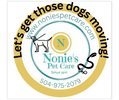
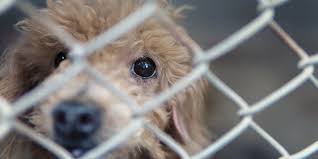

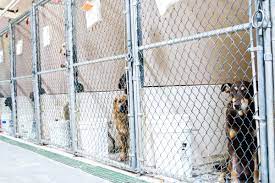
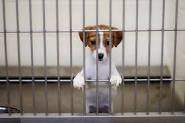
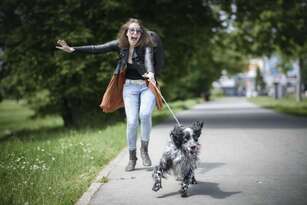
 RSS Feed
RSS Feed